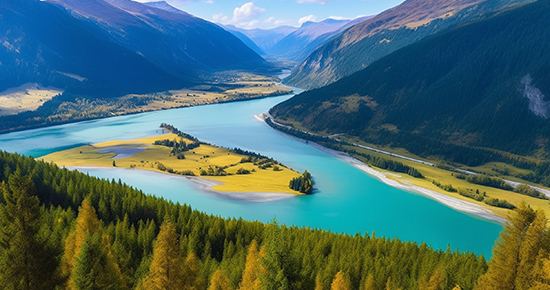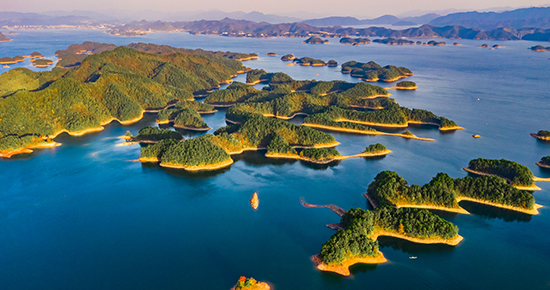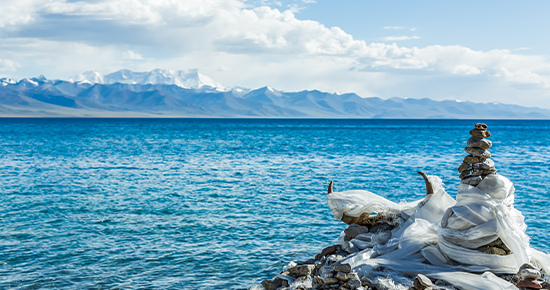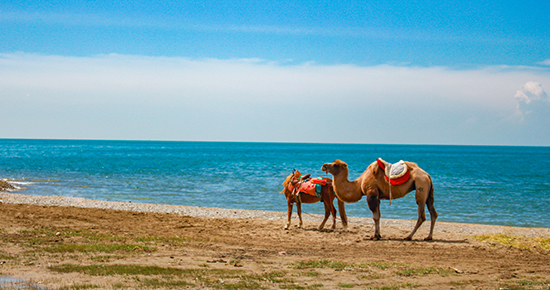Natural Attractions
Waters (rivers, lakes, waterfalls)
China is home to many rivers, lakes and waterfalls, which number over twenty thousand and are unevenly distributed. In general, the largest cluster of fresh water lakes can be discovered in middle and lower reaches of Yangtze River, while many salt river lakes and inland lakes are concentrated in Tibetan Plateau lakes. Though many of them look simple at first, they are compatible with the surroundings and the locals, generating a sense of beauty and a sense of harmony in the heart. In the meanwhile, wide ranges of species are here and there.
Kanas Lake
Kanas Lake is located in the northern part of Xinjiang, China, in the Altai region. It is one of the most beautiful alpine lakes in China. The lake water is clear and emerald green, surrounded by picturesque forests and majestic mountains. The area offers breathtaking views with pristine forests, grasslands, and canyons, hosting a unique ecosystem. Known as the "Switzerland of the East," Kanas Lake is a mysterious and enchanting place with fascinating legends. Visitors can enjoy leisurely walks along the lakeside, marvel at the magnificent natural beauty, go horseback riding, boating, or hiking to explore the surrounding landscapes. Kanas Lake is a charming tourist destination, attracting visitors to experience the tranquility and mystery of nature.

Qiandao Lake
Qiandao Lake is located in Hangzhou City, Zhejiang Province, China and is one of the largest man-made lakes in the country. The lake boasts crystal clear water and is adorned with lush green trees and numerous islands, resembling an ink painting. With a total of 1,078 islands, the lake is aptly named "Qiandao," which means "Thousand Island" in Chinese. It is a renowned tourist destination known for its picturesque landscapes. Visitors can embark on boat tours to explore the islands and indulge in the charming beauty of the lake and mountains. Fishing and boating activities are also popular, allowing visitors to unwind and relax. Surrounding the lake, there are various resorts and hot springs, offering a range of entertainment and leisure facilities. Whether it is the natural scenery or the cultural charm, Qiandao Lake leaves visitors with countless delightful memories.

West Lake
World-known for dainty landscape of lakes and mountains as well as a mass of places of historic interests, the West Lake of Hangzhou is considered A Paradise on Earth. It was included in the World Heritage List on June 24, 2011 as the only Chinese lake in that list.
Covering 6.39 square kilometers with a perimeter shore of around 15 kilometers, West Lake is a city lake just second to the Daming Lake in Jinan. The average water depth is 2.27 meters, of which the deepest is about 5 meters while the shallowest is less than 1 meter. The pretty of the West Lake not only lies in the lake itself but also in the surrounded bridges, pavilions and dozens of matched hills. Though the height of these hills are all not exceeding 400 meters, they are graceful on account of unique peaks, bizarre rocks and elegant springs, all together enhance the lake’s appeal to compose a gorgeous picture with the West lake in the middle, resembling all the stars bend towards the moon.

Boasts over 100 units of cultural relics protected under the city, province or even the state, the West Lake is a renowned historic and cultural resort with its integrated natural beauty, historic relics, artistic values and numerous affecting fairy tales. The legend of the beautiful White Snake, and the praised verse given by the distinguished poet Su Shi (苏轼, Known as Su Dongpo) of Song Dynasty (960-1279), who compared the West Lake to Xizi (one of the Four Great Beauties of ancient China), are both contributed to the romance of West Lake.
Erhai Lake
Located in Dali City, Erhai Lake is considered a Mother Lake of locals (Bai Minority) and it was cordially called as Gold Moon by Bai people. An elegant and graceful lake in plateau, Erhai Lake of Dali is the second largest freshwater lake in Yunnan Province and a seventh largest one in China. Erhai was called Yeyushui or West Erhe in ancient times. The lake got its name from its ear-shape as ear called Er in Chinese. Lying against Mt. Cangshan, Erhai Lake possesses great charms especially with a Moon Scene, which is one of the Four Greatest Scenes in Dali (other three are flowers of Shangguan, winds of Xiaguan and Snow of Mt. Cangshan. If look down in the sky, the Erhai Lake is also a crescent-shape, peacefully lying between Mount Cangshan and some dams.

With a preferable superiority in location, Erhai Lake is abundant in aquatic resources and living beings; it is an important food source for the local Bai people and used to be a royal deer ranch in old times for Nanzhao Kingdom. The lake holds a high diversity of carps with the kind named Gong Fish being the most famous which is crowned as the King of Fish. And a great variety of edible seaweed products from the lake are the favorable cuisine materials of local dishes. Definitely, Erhai is the cradle of Dali in politics, economy and culture, and plays a key part in the city’s development in water supply, agricultural irrigation, generation of electricity, climate adjustment, fishery, shipping and tourism.
Huangguoshu Waterfall
Named after a kind of common plant in the area Huangguoshu (黄果树, Huangguo Tree), the Huangguoshu Waterfall is the third largest waterfall in the world second to Niagara Falls and Victoria Falls. Consisting of 18 waterfalls of diversified styles stretching 20 kilometers, the whole Huangguoshu Waterfalls Scenic Area is magnificent with grand remarkable interlinked waterfalls, fantastic karst caves and underground lakes, and the superb beauty of ambient. It is a waterfall with a height of 77.8 meters and a width of 101 meters, of which the main waterfall is 67 meters high and 83.3 meters wide. Being a typical karst falls, the 5A national scenic area of Huangguoshu Waterfall present a amazing karst landscape with waterfall groups, a string of caves, overlapping steep peaks, dense vegetations, and countless stone forest, cliffs and gorges. A locality inhabited by Bouyi and Miao people, Huangguoshu offers more with peculiar stone buildings, unique habits and customs and the famous ethnic batik.

Heavenly Lake
Located in Fukang of Xinjiang Uygur Autonomous Region, the Heavenly Lake and the Heavenly Mountain it sits on form a natural highland scenic area surrounded by snow mountains and coniferous forest. Heavenly Mountain stretches for some 2500 km and separates Tarim Basin from Dzungarian Basin; Bogda, the highest peak, stands at 5445 meters above the sea-level.
In a shape of half-moon at an height of 1910 meters above the sea-level, the Heavenly Lake is just like a green pearl inlayed into the northern side of the Heavenly Mountain, 3400 meters in length, 800-1500 meters in width and 105 meters in deepest point. The water of the lake comes from melted snow of the surrounding mountains, hence it makes the place a well-known summer resort.

With Heavenly Lake as the center, the Heavenly Lake and Heavenly Mountain Scenic Area comprises four intact and vertical mountain land landscape belts, which covers a total area of 380.69 square km. In the mountains by Heavenly Lake there live many precious flora and fauna such as snow cocks, roe deer and saussurea involucrate. The tops of the mountains are even home to contemporary glaciers and rich in contemporary glaciers, e.g. copper, iron and mica. In 1982 Heavenly Lake and Heavenly Mountain Scenic Area became one of the first national-level scenic spots and in 1990 it was added on the list of Bogda Nature Preserve of Man and the Biosphere by the UNESCO.
Dianchi Lake
Dianchi Lake is one of the tourist spot and best summer resort since ancient time. It was named of ‘Diannan ze’ or 'The lake of Kunming’ before it is called Dianchi. Over 20 rivers flow into the lake from the east, north and south part, the water flows out from the west part and finally into the Jinsha Jiang. The shape of the lake looks like a crescent moon, with a width of 13.5km and a length of 39km. The shoreline is about 200km long and the Lake is over 300 s.q km, it is the biggest lake in Yunnan province and the 6th biggest freshwater lake in mainland China.
The elevation of the lake is 1886 meters, surrounded by tens of peaks , it is of magnificent scenery, it is called 'the pearl on the plateau'. The charming lake changes with the time, lights and cloudy changing in a single day. Dian Chi Lake is a perfect place for tourists, it has a great value in economy, shipping, fishery, irrigation, water supply, etc.

Lake Namtso (Lake Namco)
Namtso Lake is the highest salt water lake in the world and the largest lake in Tibet; it covers an area of 1920 square kilometers. It is the second largest salt water lake in China (Qinghai Lake is the largest one).
The lake is located between Damxung County (belongs to Lhasa) and the Baingoin County (he Nagqu area). The name of the lake means 'the Heaven Lake', 'the Jinnee Lake', 'the God’s Lake'; it is also a holy place for Buddhism, believers respect the lake as one of the four great lakes and the five islands in Namtso is the embodiment of the Five Dhyani Buddhas.
Namtso Lake is wide and full of natural resources; it is available to pasture all year round. Every summer, clustered wild ducks fly to the lake to rest and to raise up seed, wild yaks, write yaks, fishes, worm grass, etc.

The shape of the lake looks like a lying Tara (Tara is known to the Tibetans as The Faithful One, The Fierce Protectress), the tortoise beam, the peacock beam, and totally 18 beams are located in the south of the lake, 18 islands locate in north part of the lake, four temples was built around the lake and stands for the 'Gentle' 'Indignant' 'Power' and 'Rights' mentioned in the Buddhism.
Lugu Lake
Lugu Lake is over 50 square kilometers, it is of an elevation of 2690 meters and an average water depth of 45 meters, the lake is the highest lake of Yunnan province and one of the deepest freshwater lakes in China.
The lake includes 5 islands, 3 peninsulas and 1 seawall island, the Heiwawu Island, Liwubi Island and Lige Island are renewed as the "the three islands from the fabled abode of immortals", the three islands are also the most popular place worth to see at Lugu Lake.
There are about 1,300,0 people living along the bank of the lake, 45% of them are Mosuo minority people, other nationality are Yi, Han, Naxi, Tibetean, Bai, Zhuang and Pumi. Mosuo people is an ancient minority, it keeps the matriarchal society way of living, the people and minority is regarded as the ‘living fossil of matriarchal society of human’, unique and quite interesting.

Qinghai Lake
Qinghai Lake, literally Blue Lake, is called Koke nuur by Mongolian, which identically means blue lake. Located in Qinghaihu Basin, northeast of Qinghai Province, it is the largest inland lake as well as the largest saline lake in China. The source of Qinghai Lake relies on the direct runoff and rainfalls, as well, another over 40 rivers empty into the lake with the Buha River being the largest.
Qinghai Lake is enveloped by lofty mountains, and it has two sub-lakes, a saline Gahai Lake and a freshwater Erhai Lake. The open lakeside terrain, sufficient water and temperate weather make the area a natural pasture with lush waterweeds and offer the lake vast grasslands, numerous rivers, and quiet and secluded ambient. The picturesque beauty of Qinghai Lake is consists of a verdant grassland dotted with flocks of sheep and goats, the fragrant golden rape flowers waving with the breeze, shepherds’ tents scattered around the lake, and the charming sceneries presented during the sunrises and sunsets.

Being a miraculous tourist site, Qinghai Lake provide more as a enormous treasured lake drawing great attentions from scientists from the world. Despite its salinity, the lake has an abundance of fish and reckoned as the largest natural fish base in northwest China and it particularly teem with edible naked carp. Ample mineral resources are also explored in the lake. To visit Qinghai Lake, it is the enjoyment of plateau pasturing area, and much more than this are a ride of yak wandering on the grassland, a climb for sand dune, a visit in a local Mongolian herbsman, and an experience staying in Mongolian tent, tasting of delicate snacks of local favors, such as milky tea, buttered tea, fried noodles and barley wine.